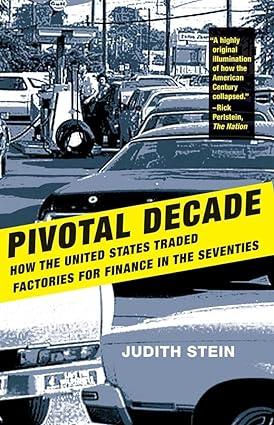Question 1: What are the charges that Coca-cola is facing in India? Do you think they are ethical or unethical, why?
Question 2: Which consequences these charges are bringing? Do you think Pepsi and other soft drink investment in India are causing more dilemmas for Coca-cola?
Question 3: Which action that Coca-Cola has taken to solve those charges?
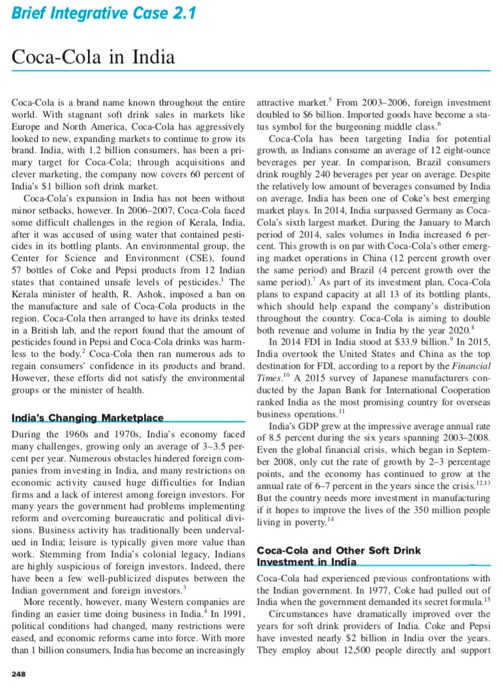
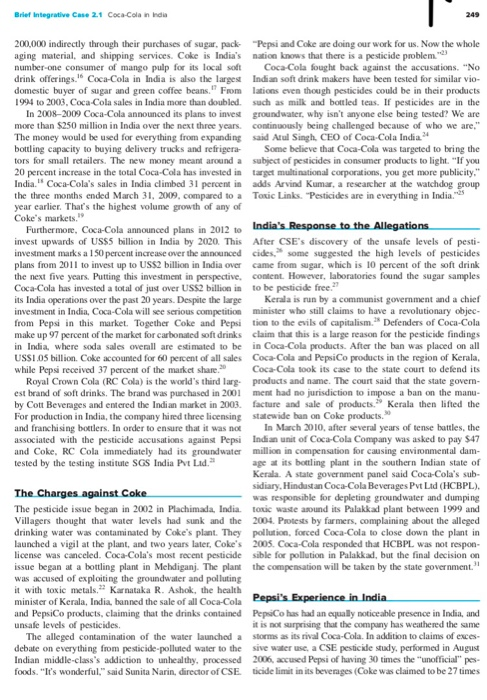
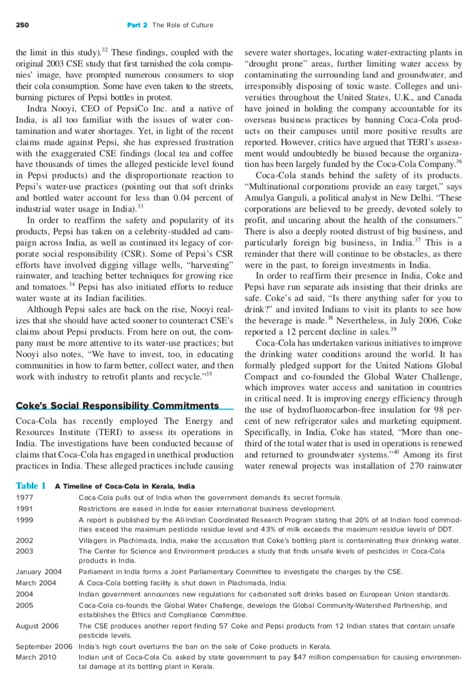
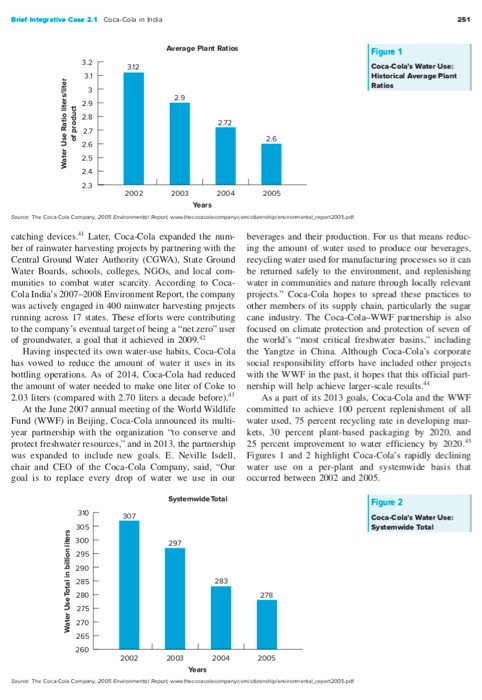
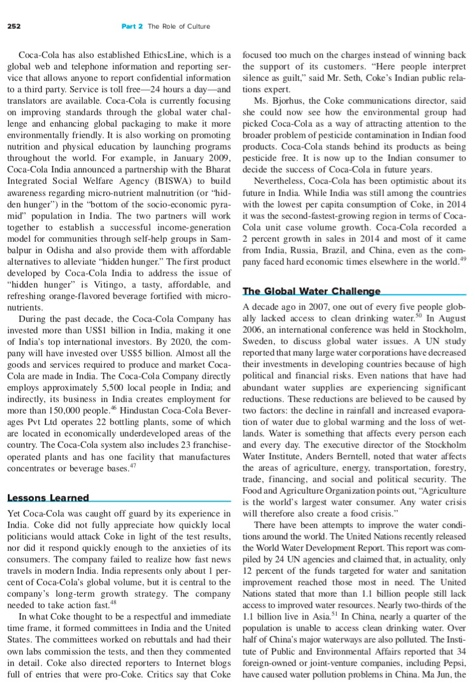
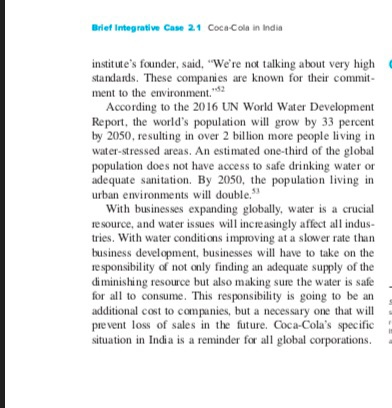
Brief Integrative Case 2.1 Coca-Cola in India Coca-Cola is a brand name known throughout the entire attractive market. From 2003-2006, foreign investment world. With stagnant soft drink sales in markets like doubled to $6 billion. Imported goods have become a sta- Europe and North America, Coca-Cola has aggressively tus symbol for the burgeoning middle class." looked to new, expanding markets to continue to grow its Coca-Cola has been targeting India for potential brand. India, with 1.2 billion consumers, has been a pri- growth, as Indians consume an average of 12 eight-ounce mary target for Coca-Cola; through acquisitions and beverages per year. In comparison, Brazil consumers clever marketing, the company now covers 60 percent of drink roughly 240 beverages per year on average. Despite India's S1 billion soft drink market. the relatively low amount of beverages consumed by India Coca-Cola's expansion in India has not been without on average, India has been one of Coke's best emerging minor setbacks, however. In 2006-2007, Coca-Cola faced market plays. In 2014, India surpassed Germany as Coca- some difficult challenges in the region of Kerala, India, Cola's sixth largest market. During the January to March after it was accused of using water that contained pesti- period of 2014, sales volumes in India increased 6 per- cides in its bottling plants. An environmental group, the cent. This growth is on par with Coca-Cola's other emerg- Center for Science and Environment (CSE), founding market operations in China (12 percent growth over 57 bottles of Coke and Pepsi products from 12 Indian the same period) and Brazil (4 percent growth over the states that contained unsafe levels of pesticides. The same period). As part of its investment plan, Coca-Cola Kerala minister of health, R. Ashok, imposed a ban on plans to expand capacity at all 13 of its bottling plants, the manufacture and sale of Coca-Cola products in the which should help expand the company's distribution region. Coca-Cola then arranged to have its drinks tested throughout the country. Coca-Cola is aiming to double in a British lab, and the report found that the amount of both revenue and volume in India by the year 2020, pesticides found in Pepsi and Coca-Cola drinks was harm- In 2014 FDI in India stood at $33.9 billion. In 2015, less to the body. Coca-Cola then ran numerous ads to India overtook the United States and China as the top regain consumers' confidence in its products and brand destination for FDI, according to a report by the Financial However, these efforts did not satisfy the environmental Times. A 2015 survey of Japanese manufacturers con- groups or the minister of health. ducted by the Japan Bank for International Cooperation ranked India as the most promising country for overseas India's Changing Marketplace business operations." During the 1960s and 1970s, India's economy faced of 8.5 percent during the six years spanning 2003-2008 India's GDP grew at the impressive average annual rate many challenges, growing only an average of 3-3.5 per. Even the global financial crisis, which began in Septem- cent per year. Numerous obstacles hindered foreign com ber 2008, only cut the rate of growth by 2-3 percentage panies from investing in India, and many restrictions on points, and the economy has continued to grow at the economic activity caused huge difficulties for Indian annual rate of 6-7 percent in the years since the crisis. 12.13 firms and a lack of interest among foreign investors. For But the country needs more investment in manufacturing many years the government had problems implementing if it hopes to improve the lives of the 350 million people reform and overcoming bureaucratic and political divi living in poverty. sions. Business activity has traditionally been underval- ued in India: leisure is typically given more value than work. Stemming from India's colonial legacy, Indians Coca-Cola and Other Soft Drink are highly suspicious of foreign investors. Indeed, there Investment in India have been a few well-publicized disputes between the Coca-Cola had experienced previous confrontations with Indian government and foreign investors. the Indian government. In 1977, Coke had pulled out of More recently, however, many Western companies are India when the government demanded its secret formula." finding an easier time doing business in India. In 1991, Circumstances have dramatically improved over the political conditions had changed, many restrictions were years for soft drink providers of India Coke and Pepsi eased, and economic reforms came into force. With more have invested nearly $2 billion in India over the years. than 1 billion consumers, India has become an increasingly They employ about 12,500 people directly and support 248 Brief Integrative Case 2.1 Coca-Cola in India 249 200,000 indirectly through their purchases of sugar, pack Pepsi and Coke are doing our work for us. Now the whole aging material, and shipping services. Coke is India's nation knows that there is a pesticide problem. m number one consumer of mango pulp for its local soft Coca-Cola fought back against the accusations. "No drink offerings. Coca-Cola in India is also the largest Indian soft drink makers have been tested for similar vio- domestic buyer of sugar and green coffee beans." From lations even though pesticides could be in their products 1994 to 2003. Coca-Cola sales in India more than doubled such as milk and bottled teas. If pesticides are in the In 2008-2009 Coca-Cola announced its plans to invest groundwater, why isn't anyone else being tested? We are more than $250 million in India over the next three years. continuously being challenged because of who we are," The money would be used for everything from expanding said Atul Singh, CEO of Coca-Cola India 34 bottling capacity to buying delivery trucks and refrigera- Some believe that Coca-Cola was targeted to bring the tors for small retailers. The new money meant around a subject of pesticides in consumer products to light. "If you 20 percent increase in the total Coca-Cola has invested in target multinational corporations, you get more publicity." India." Coca-Cola's sales in India climbed 31 percent in adds Arvind Kumar, a researcher at the watchdog group the three months ended March 31, 2009, compared to a Toxic Links. "Pesticides are in everything in India." year earlier. That's the highest volume growth of any of Coke's markets." Furthermore, Coca-Cola announced plans in 2012 to India's Response to the Allegations invest upwards of US$5 billion in India by 2020. This After CSE's discovery of the unsafe levels of pesti- investment marks a 150 percent increase over the announced cides, some suggested the high levels of pesticides plans from 2011 to invest up to US$2 billion in India over came from sugar, which is 10 percent of the soft drink the next five years. Putting this investment in perspective content. However, laboratories found the sugar samples Coca-Cola has invested a total of just over US$2 billion in to be pesticide free. its India operations over the past 20 years. Despite the large Kerala is run by a communist government and a chief investment in India, Coca-Cola will see serious competition minister who still claims to have a revolutionary objec- from Pepsi in this market. Together Coke and Pepsi tion to the evils of capitalism." Defenders of Coca-Cola make up 97 percent of the market for carbonated soft drinks claim that this is a large reason for the pesticide findings in India, where soda sales overall are estimated to be in Coca-Cola products. After the ban was placed on all USSIO5 billion. Coke accounted for 60 percent of all sales Coca-Cola and PepsiCo products in the region of Kerala, while Pepsi received 37 percent of the market share. Coca-Cola took its case to the state court to defend its Royal Crown Cola (RC Cola) is the world's third larg products and name. The court said that the state gover- est brand of soft drinks. The brand was purchased in 2001 ment had no jurisdiction to impose a ban on the manu- by Cott Beverages and entered the Indian market in 2003. facture and sale of products." Kerala then lifted the For production in India, the company hired three licensing statewide ban on Coke products, and franchising bottlers. In order to ensure that it was not In March 2010, after several years of tense battles, the associated with the pesticide accusations against Pepsi Indian unit of Coca-Cola Company was asked to pay $47 and Coke, RC Cola immediately had its groundwater million in compensation for causing environmental dam- tested by the testing institute SGS India Pvt Lad." age at its bottling plant in the southern Indian state of Kerala. A state government panel said Coca-Cola's sub- sidiary, Hindustan Coca-Cola Beverages Pvt Ltd (HCBPL). The Charges against coke was responsible for depleting groundwater and dumping The pesticide issue began in 2002 in Plachimada, India. toxic waste around its Palakkad plant between 1999 and Villagers thought that water levels had sunk and the 2004. Protests by farmers, complaining about the alleged drinking water was contaminated by Coke's plant. They pollution, forced Coca-Cola to close down the plant in launched a vigil at the plant, and two years later, Coke's 2005. Coca-Cola responded that HCBPL was not respon license was canceled. Coca-Cola's most recent pesticidesible for pollution in Palakkad, but the final decision on issue began at a bottling plant in Mehdiganj. The plant the compensation will be taken by the state government. was accused of exploiting the groundwater and polluting it with toxic metals." Karnataka R. Ashok, the health minister of Kerala, India, banned the sale of all Coca-Cola Pepsi's Experience in India and PepsiCo products, claiming that the drinks contained PepsiCo has had an equally noticeable presence in India, and unsafe levels of pesticides it is not surprising that the company has weathered the same The alleged contamination of the water launched a storms as its rival Coca-Cola. In addition to claims of exces- debate on everything from pesticide-polluted water to the sive water use, a CSE pesticide study, performed in August Indian middle-class's addiction to unhealthy, processed 2006, accused Pepsi of having 30 times the unofficialpes- foods. "It's wonderful," said Sunita Narin, director of CSE ticide limit in its beverages (Coke was claimed to be 27 times 250 Part 2 The Role of Culture the limit in this study). "These findings, coupled with the severe water shortages, locating water-extracting plants in original 2003 CSE study that first tarnished the cola compo "drought prone" areas, further limiting water access by nies' image, have prompted numerous consumers to stop contaminating the surrounding land and groundwater, and their cola consumption. Some have even taken to the streets, irresponsibly disposing of toxic waste. Colleges and uni- burning pictures of Pepsi bottles in protest versities throughout the United States, UK and Canada Indra Nooyi, CEO of PepsiCo Inc. and a native of have joined in holding the company accountable for its India, is all too familiar with the issues of water con- overseas business practices by banning Coca-Cola prod- tamination and water shortages. Yet, in light of the recent ucts on their campuses until more positive results are claims made against Pepsi, she has expressed frustration reported. However, critics have argued that TERI's assess- with the exaggerated CSE findings (local tea and coffee ment would undoubtedly be biased because the organiza have thousands of times the alleged pesticide level found tion has been largely funded by the Coca-Cola Company." in Pepsi products) and the disproportionate reaction to Coca-Cola stands behind the safety of its products. Pepsi's water-use practices (pointing out that soft drinks "Multinational corporations provide an easy target," says and bottled water account for less than 0.04 percent of Amulya Ganguli, a political analyst in New Delhi. "These industrial water usage in India)." corporations are believed to be greedy, devoted solely to In order to reaffirm the safety and popularity of its profit, and uncaring about the health of the consumers." products, Pepsi has taken on a celebrity-studded ad cam- There is also a deeply rooted distrust of big business, and paign across India as well as continued its legacy of cor particularly foreign big business, in India. This is a porate social responsibility (CSR). Some of Pepsi's CSR reminder that there will continue to be obstacles, as there efforts have involved digging village wells, "harvesting" were in the past, to foreign investments in India. rainwater, and teaching better techniques for growing rice In order to reaffirm their presence in India, Coke and and tomatoes. Pepsi has also initiated efforts to reduce Pepsi have run separate ads insisting that their drinks are water waste at its Indian facilities, safe. Coke's ad said, "Is there anything safer for you to Although Pepsi sales are back on the rise, Nooyi real. drink?" and invited Indians to visit its plants to see how izes that she should have acted sooner to counteract CSE's the beverage is made. Nevertheless, in July 2006, Coke claims about Pepsi products. From here on out, the com- reported a 12 percent decline in sales." pany must be more attentive to its water-use practices, but Coca-Cola has undertaken various initiatives to improve Nooyi also notes, "We have to invest, too, in educating the drinking water conditions around the world. It has communities in how to form better collect water, and then formally pledged support for the United Nations Global work with industry to retrofit plants and recycle." Compact and co-founded the Global Water Challenge. which improves water access and sanitation in countries in critical need. It is improving energy efficiency through Coke's Social Responsibility Commitments the use of hydrofluorocarbon-free insulation for 98 per- Coca-Cola has recently employed The Energy and cent of new refrigerator sales and marketing equipment. Resources Institute (TERI) to assess its operations in Specifically, in India. Coke has stated. More than one- India. The investigations have been conducted because of third of the total Water that is used in operations is renewed claims that Coca-Cola has engaged in unethical production and returned to groundwater systems. *** Among its first practices in India. These alleged practices include causing water renewal projects was installation of 270 rainwater Table 1 A Timeline of Coca-Cola in Kerala, India 1977 Coca Cola puls out of India when the government demands ts secret formula 1991 Restrictions we eased in India for easier International business development 1999 A report is published by the All Indian Coordinated Research Program stating that 20% of all Indian food commod- ities exceed the maximum pesticide residue level and 43% of mik exceeds the maximum residue levels of DOT 2002 Villagers in Plachimada, India, make the accusation that Coke's bottling plant is contaminating ther drinking water, 2003 The Center for Science and Environment produces a study that finds unsate levels of pesticides in Coca-Cola products in India. January 2004 Parliament in India forms a Joint Parliamentary Committee to investigate the charges by the CSE. March 2004 A Coca-Cola botting facilty is shut down in Plochimada, India 2004 Indian government announces new regulations for carbonated soft drinks based on European Union standards 2005 Coca-Cola co-founds the Global Water Chalenge, develops the Global Community Watershed Partnership, and establishes the Ethics and Compliance Committee August 2006 The CSE produces another report finding 57 Coke and Pepsi products from 12 Indian states that contain unsafe pesticide levels September 2006 India's high court overturns the ban on the sale of Coke products in Kerala. March 2010 Indian unt of Coca-Cola Co asked by state government to pay $47 million compensation for causing environmen tal damage at its betting plant in Kerala Briet Integrative Case 2.1 Coca-Cola in India 251 NN Water Use Ratio litersliter of product 111 11 Average Plant Ratios Figure 1 3.2 312 Coca-Cola's Water Uses 3.1 Historical Average Plant 3 Ratios 2.9 2.9 2.8 2.72 2.7 26 26 2.5 2.4 23 2002 2003 2004 2005 Years Source: The Coca-Cola Company, 2005 Euro Report www.theco.com portreport2005.pd catching devices." Later, Coca-Cola expanded the num- beverages and their production. For us that means reduc- ber of rainwater harvesting projects by partnering with the ing the amount of water used to produce our beverages, Central Ground Water Authority (CGWA), State Ground recycling water used for manufacturing processes so it can Water Boards, schools, colleges, NGOs, and local com- be returned safely to the environment, and replenishing munities to combat water scarcity. According to Coca- water in communities and nature through locally relevant Cola India's 2007-2008 Environment Report, the company projects." Coca-Cola hopes to spread these practices to was actively engaged in 400 rainwater harvesting projects other members of its supply chain, particularly the sugar running across 17 states. These efforts were contributing cane industry. The Coca-Cola-WWF partnership is also to the company's eventual target of being a "net zero" user focused on climate protection and protection of seven of of groundwater, a goal that it achieved in 2009.62 the world's most critical freshwater basins," including Having inspected its own water-use habits, Coca-Cola the Yangtze in China. Although Coca-Cola's corporate has vowed to reduce the amount of water it uses in its social responsibility efforts have included other projects bottling operations. As of 2014, Coca-Cola had reduced with the WWF in the past, it hopes that this official part- the amount of water needed to make one liter of Coke tonership will help achieve larger-scale results. 2.03 liters (compared with 2.70 liters a decade before). As a part of its 2013 goals, Coca-Cola and the WWF At the June 2007 annual meeting of the World Wildlife committed to achieve 100 percent replenishment of all Fund (WWF) in Beijing, Coca-Cola announced its multi- water used, 75 percent recycling rate in developing mar- year partnership with the organization to conserve and kets, 30 percent plant-based packaging by 2020, and protect freshwater resources," and in 2013, the partnership 25 percent improvement to water efficiency by 2020. was expanded to include new goals. E. Neville Isdell. Figures 1 and 2 highlight Coca-Cola's rapidly declining chair and CEO of the Coca-Cola Company, said, "Our water use on a per-plant and systemwide basis that goal is to replace every drop of water we use in our occurred between 2002 and 2005 Systemwide Total Figure 2 310 307 Coca-Cola's Water Use: 305 System wide Total 300 297 6 295 290 285 283 280 278 275 270 265 260 2002 2008 2004 2005 Water Use Total in billion liters Years Source: The Coca-Cola Company 2005 Domental Report www.thecocaco.com www.2005 252 Part 2 The Role of Culture Coca-Cola has also established EthicsLine, which is a focused too much on the charges instead of winning back global web and telephone information and reporting ser- the support of its customers. "Here people interpret vice that allows anyone to report confidential information silence as guilt," said Mr. Seth, Coke's Indian public rela- to a third party. Service is toll free-24 hours a day-and tions expert. translators are available. Coca-Cola is currently focusing Ms. Bjorhus, the Coke communications director, said on improving standards through the global water chal- she could now see how the environmental group had lenge and enhancing global packaging to make it more picked Coca-Cola as a way of attracting attention to the environmentally friendly. It is also working on promoting broader problem of pesticide contamination in Indian food nutrition and physical education by launching programs products. Coca-Cola stands behind its products as being throughout the world. For example, in January 2009. pesticide free. It is now up to the Indian consumer to Coca-Cola India announced a partnership with the Bharat decide the success of Coca-Cola in future years. Integrated Social Welfare Agency (BISWA) to build Nevertheless, Coca-Cola has been optimistic about its awareness regarding micro-nutrient malnutrition (or hid- future in India. While India was still among the countries den hunger") in the bottom of the socio-economic pyra- with the lowest per capita consumption of Coke, in 2014 mid" population in India. The two partners will work it was the second-fastest-growing region in terms of Coca- together to establish a successful income-generation Cola unit case volume growth. Coca-Cola recorded a model for communities through self-help groups in Sam- 2 percent growth in sales in 2014 and most of it came balpur in Odisha and also provide them with affordable from India, Russia, Brazil, and China, even as the com- alternatives to alleviate "hidden hunger." The first product pany faced hard economic times elsewhere in the world." developed by Coca-Cola India to address the issue of "hidden hunger" is Vitingo, a tasty, affordable, and refreshing orange-flavored beverage fortified with micro The Global Water Challenge nutrients. A decade ago in 2007, one out of every five people glob- During the past decade, the Coca-Cola Company has ally lacked access to dean drinking water. In August invested more than US$1 billion in India, making it one 2006, an international conference was held in Stockholm, of India's top international investors. By 2020, the com- Sweden, to discuss global water issues. A UN study pany will have invested over US$5 billion. Almost all the reported that many large water corporations have decreased goods and services required to produce and market Coca- their investments in developing countries because of high Cola are made in India. The Coca-Cola Company directly political and financial risks. Even nations that have had employs approximately 5,500 local people in India, and abundant water supplies are experiencing significant indirectly, its business in India creates employment for reductions. These reductions are believed to be caused by more than 150,000 people. Hindustan Coca-Cola Bever- two factors: the decline in rainfall and increased evapora- ages Pvt Led operates 22 bottling plants, some of which tion of water due to global warming and the loss of wet- are located in economically underdeveloped areas of the lands. Water is something that affects every person each country. The Coca-Cola system also includes 23 franchise- and every day. The executive director of the Stockholm operated plants and has one facility that manufactures Water Institute, Anders Bertell, noted that water affects concentrates or beverage bases." the areas of agriculture, energy, transportation, forestry, trade, financing, and social and political security. The Lessons Learned Food and Agriculture Organization points out, "Agriculture is the world's largest water consumer. Any water crisis Yet Coca-Cola was caught off guard by its experience in will therefore also create a food crisis." India. Coke did not fully appreciate how quickly local There have been attempts to improve the water condi- politicians would attack Coke in light of the test results. tions around the world. The United Nations recently released nor did it respond quickly enough to the anxieties of its the World Water Development Report. This report was com- consumers. The company failed to realize how fast news piled by 24 UN agencies and claimed that, in actuality, only travels in modern India. India represents only about I per- 12 percent of the funds targeted for water and sanitation cent of Coca-Cola's global volume, but it is central to the improvement reached those most in need. The United company's long-term growth strategy. The company Nations stated that more than 11 billion people still lack needed to take action fast." access to improved water resources. Nearly two-thirds of the In what Coke thought to be a respectful and immediate L1 billion live in Asia. In China, nearly a quarter of the time frame, it formed committees in India and the United population is unable to access clean drinking water. Over States. The committees worked on rebuttals and had their half of China's major waterways are also polluted. The Insti- own labs commission the tests, and then they commented tute of Public and Environmental Affairs reported that 34 in detail. Coke also directed reporters to Internet blogs foreign-owned or joint-venture companies, including Pepsi, full of entries that were pro-Coke. Critics say that Coke have caused water pollution problems in China. Ma Jun, the Brief Integrative Case 21 Coca-Cola in India institute's founder, said, "We're not talking about very high standards. These companies are known for their commit- ment to the environment. 82 According to the 2016 UN World Water Development Report, the world's population will grow by 33 percent by 2050, resulting in over 2 billion more people living in water-stressed areas. An estimated one-third of the global population does not have access to safe drinking water or adequate sanitation. By 2050, the population living in urban environments will double." With businesses expanding globally, water is a crucial resource, and water issues will increasingly affect all indus- tries. With water conditions improving at a slower rate than business development, businesses will have to take on the responsibility of not only finding an adequate supply of the diminishing resource but also making sure the water is safe for all to consume. This responsibility is going to be an additional cost to companies, but a necessary one that will prevent loss of sales in the future. Coca-Cola's specific situation in India is a reminder for all global corporations












